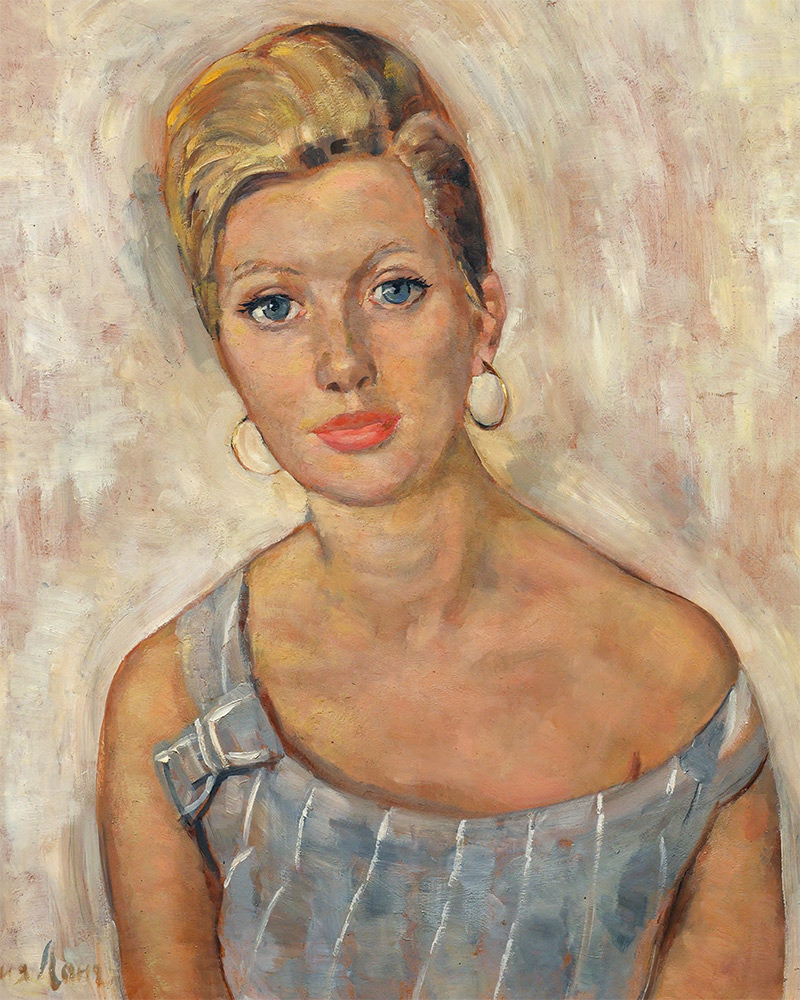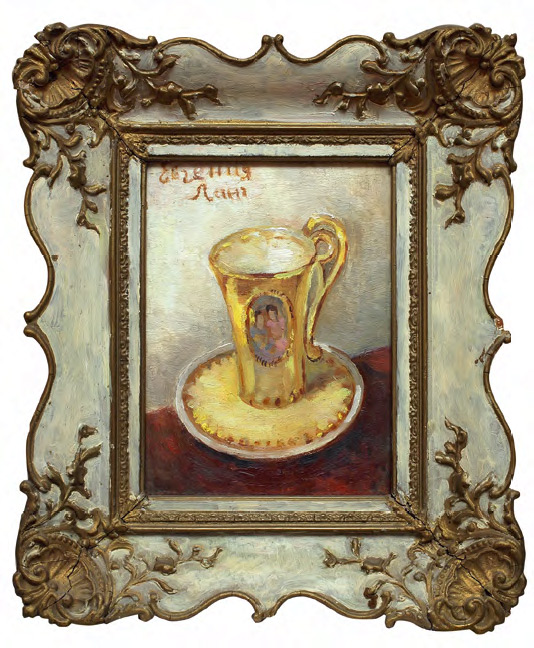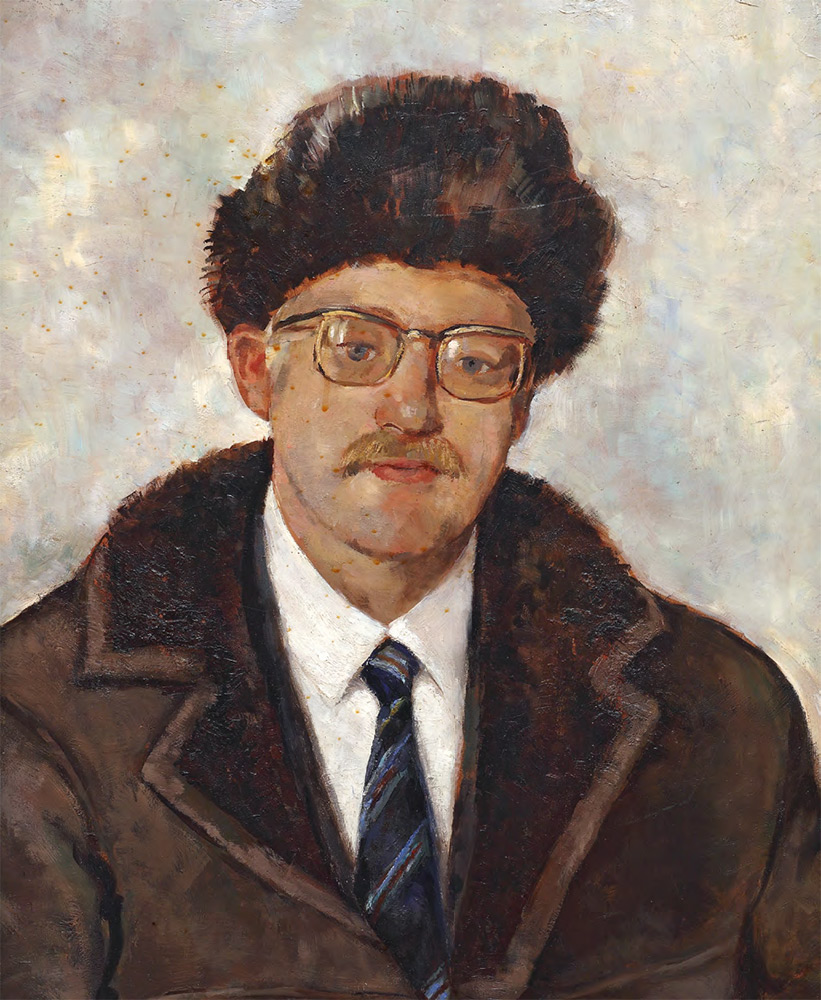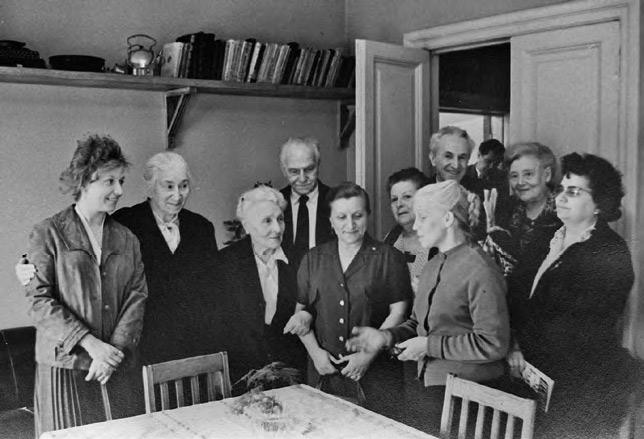Remembering Yevgenia Lang
FOUR DECADES IN FRANCE, RETURN TO MOSCOW, RECOLLECTIONS OF MAYAKOVSKY
The artist Yevgenia Lang (1890-1973) was an acquaintance of my aunt, Lyudmila Mayakovskaya, the sister of the poet Vladimir Mayakovsky. My aunt was closely involved in my education, hoping to prepare me to take over the mission of preserving the great poet’s legacy and studying his work.[1] Lyudmila, an artist herself introduced me to many interesting personalities from the world of art and literature of her time, and I developed a particular friendship with Lang.

Yevgenia Lang and Svetlana Volodina. Photograph. 1960s
Born into a family of the intelligentsia, she was a cousin of the poet Valery Bryusov. Her father, Alexander Lang, was Russian, but his family had ancient Scottish roots.[2] He was a well-known bookseller in Moscow, his bookshop located near Kuznetsky Most (the building now houses a watch repair shop).
Yevgenia graduated from a gymnasium and later from the historical faculty of the Higher Courses for Women (the Bestuzhev Courses), but her dedication to painting remained with her throughout her life. Her first teacher was Vasily Meshkov, and she later entered the Moscow School of Painting, Sculpture and Architecture, where she studied together with Mayakovsky, whom she had known earlier (they had been students at the same school). From her earliest years onwards, Yevgenia's aspiration was to create, and even during the hardest periods of her life it was the only means that she chose for supporting herself; later, in Paris, she even painted brooches.
From 1922 to 1924, she studied at the Dresden Academy of Fine Arts, but did not return to Russia on completing her course. Figurative art was the centre of her world and she thought that it would be impossible for her to make her living in post-revolutionary Russia, where the traditions of classical painting had been so completely overthrown, by relying on her talents. And she was talented, in portraiture, still-life and landscapes.
So she travelled to France, where she would remain for some 40 years. Lang participated in the Paris salons and group shows: at the Salon des Tuileries, in 1939, where she was awarded the silver medal for her painting “La femme au scarabee’’ (Woman with a Scarab Amulet), in the Salon of Decorative Painters (1939), in the Salon d'Automne (1937, 1943), in the Salon des Independants (1945-1948), in the Salon of Modern Art (1946), the Salon of Women Artists (1947, 1948, 1957, 1958), and in the Spring Salon (1947, 1948). Moreover, she had a number of solo exhibitions in Paris, Nice, Monaco and Brussels. In 1950, she was awarded the Grand Prix for painting at the Monaco Biennale, which later brought her commissions to paint the portraits of Prince Rainier of Monaco and of his new young wife, the American actress Grace Kelly. In 1955, Lang took part in the Exhibition of Esoteric Painters.

Portrait of Svetlana Volodina. 1960s
Oil on cardboard. Property of Svetlana Volodina
Despite such artistic success and numerous commissions, Lang's life in France was far from easy. She never took French citizenship and held a Nansen passport as a stateless person, which was particularly risky under the Nazi occupation. She was forced to hide, frequently moving from one acquaintance to another - all this time accompanied by her two cats, always her loyal friends.[3]
In 1962, Yevgenia visited the Soviet Union as a tourist and sought out Lyudmila Mayakovskaya, whom she had known as a student. They had a great deal to discuss, most importantly Vladimir Mayakovsky, with whom Lang had become friends at school, later remaining in touch with him while they were art students (she painted a portrait of him from memory). Once, when visiting Lyudmila, she saw an antique coffee cup and remembered that Mayakovsky had once wanted to give it to her as a present: they had gone to an antiques auction, where she had seen the cup, liking it very much. Mayakovsky had decided to buy it for her as a present, but having no money on him he promised to return the following day. However, they never met again, as that was the day when Mayakovsky would meet the Briks for the first time. Nevertheless, he must have bought the cup, as he had promised. Yevgenia twice painted pictures of that cup, giving one copy to Lyudmila, the other to me.

Little Cup. 1960s
Oil on cardboard. Property of Svetlana Volodina
Yevgenia mentioned a school magazine, produced by the hectograph duplication method, that the students of her gymnasium established to publish their literary works, including those of Mayakovsky, whose first poems appeared there: it a was story that raised doubts, since no one had ever heard of such an endeavour. But soon afterwards we did indeed come across the magazine “Poryv" (Impulse) a copy of which was brought by a member of the public to the Mayakovsky Museum!
When she visited Moscow, Yevgenia could not find her father's tomb at the German Cemetery [the Vveden- skoye Cemetery, in Lefortovo]: she remembered where it had been, but the place had changed beyond recognition. I took her around Moscow a lot, and she would always bring her sketchbook and pencils. At Tsaritsyno, she made a stunning drawing of a half-ruined grotto.
She wanted to come home to Russia, and Lyudmila helped her with the process. Yevgenia received a decent one-room apartment - in Paris, it would be called an atelier - near the Borodin Bridge; she became a member of the Union of Artists. She gave many of her works to Lyudmila, which are now kept at the Mayakovsky Museum.
In such a way, this friendship between the two women was rekindled in later years. They met often and would talk endlessly about life, about art and, of course, about Mayakovsky. Yevgenia was always glad to remember him, since these were the joyful memories of her youth... On a special pedestal in her studio apartment she kept Mayakovsky's death mask, which she had received from the Georgian film director Konstantin Pipinashvili, who had made the 1958 film “This Is How Mayakovsky Began". (The mask must now be at the Mayakovsky Museum, since Lyudmila survived
Yevgenia by three years.) I had visited Mayakovsky's hometown of Baghdati in Georgia with my aunt for the shooting of Pipinashvili's film; the town was named in those days after Mayakovsky. We stayed in the family house, which was - and remains - a museum. What paradise it was! (As Mayakovsky wrote, “I know, these Edens, these heavens are naught but foolery! But the poets who sang of them surely meant that joyful land, Georgia.")
Yevgenia received a good pension, but she also earned some money from her work as an artist, most of all because it was almost impossible for her to put down her brush. She painted still-lifes and portraits, selling them for next to nothing, or often giving them away for free. All my friends decorated their homes with her wonderful works. As well as her still-lifes - Yevgenia loved painting flowers - I have three portraits of myself and one of my late husband Lev Volodin, the journalist and specialist in international relations.

Portrait of Lev Volodin. 1960s
Oil on cardboard. Property of Svetlana Volodina
There was no end to her portrait commissions. Yevgenia had a large number of acquaintances desiring to purchase portraits by this famous French artist, among them Vladimir Serov, Vladimir Kemenov and Wolf Messing [the hypnotist and psychic]. The last of those had an especially warm friendship with Yevgenia, because she was interested in mysticism. Once when I was about to depart for Paris, she asked me to take flowers to the grave of the founder of French mysticism, Allan Kardec, at the Pere Lachaise Cemetery. I looked for it for hours (no plan of the cemetery was available) until I was ready to give up; then I looked down at my feet, and saw the inscription “Allan Kardec’’! Yevgenia later commented on my story, saying: “That was how it was meant to be."
When I first visited her at home, my eye fell on a painting of white bellflowers. I was so enraptured that I forgot that principle of Bulgakov of “never asking for anything", by which I normally live, and suddenly blurted out the request that she give the piece to me as a present. But she refused: she did so gently, saying something about how the painting evoked many intimate memories and was very dear to her. Several days later I noticed that the painting was no longer hanging on the wall; instead it stood wrapped in paper by the door. “I would like to give you my favourite painting," Yevgenia told me. I would receive many more of her canvases later, but my collection started with those bellflowers.
I own a modest dacha with a garden that is far from the fashions of landscape design. I buy and plant flowers, and some of them do survive, though mostly it is ground elder that takes over. But several years ago, suddenly perennial bellflowers started appearing, so many of them! They sprung up in every corner of the garden, the first ones right under my window. The flowers were just the same as in the painting! And none would flower at any of my neighbours, as if they were just for me. I am so glad that Yevgenia is reminding me not to forget her.

Lyudmila Mayakovskaya with her family and friends at the Mayakovsky Museum on Gendrikov Lane in Moscow. From left to right: Svetlana Volodina, Lyudmila Mayakovskaya, Natalya Strom, Khristofor Stavrakov, my mother Tatyana Kiseleva, Yevgeny Kitin, museum employee, Yevgenia Lang, Lyudmila Koiranskaya. Photograph. Early 1960s
She was one of those people who not only influenced my view of life and my education, but who also actually shaped it. She had a French friend, a teacher, whose pension allowed her to travel abroad twice a year. When she visited Yevgenia in Moscow, she was told to bring various books for me. Thus I read for the first time, in French, “Gone with the Wind" by Margaret Mitchell, “The Morning of the Magicians" by Jacques Bergier and Louis Pauwels, “The Story of San Michele" by Axel Munthe, Mary Webb's “Sarn" [the French translation of the early 20th century English romantic novelist's most famous work, “Precious Bane"], and “The Silence of Colonel Bramble" by Andre Maurois, “Impressions de voyage: En Russie" by Alexandre Dumas, the works of Madame Blavatsky, and the two-volume “Tibetan Journey" by Alexandra David-Neel. That last one, as well as being marvellous memories of the author's journey, contained the earliest recollections of Hitler that I had encountered (in Soviet times). The author had travelled to Tibet via Berlin, where she stayed with friends, and on her very first evening there they took her to listen to Hitler speaking, as if it was the best attraction that could be offered to a visitor. His speech impressed her so much that on the following day, as soon as she woke up, she rushed to a newspaper stand to find its full text. She could barely believe her eyes: it contained nothing but generalities, the kind of commonplace ideas and banalities that could be listened to only under hypnosis.
Yevgenia passed on to me not only knowledge, she also gently taught me various practical skills. It was a matter of principle for her that she never occupied herself with a housewife's duties; she believed that the funds she earned by painting should cover all such services. She never cooked or did the laundry herself, so that even in her old age she had the most beautiful hands.
I worked at the Academy of Arts, close to Yevgenia's home, which meant that I would come to visit her almost every day. She did not leave home, and I brought her food, sometimes cooking for her, though that was certainly not the main thing for her. Most importantly, I was her listener as she talked about life, painting and literature; she could talk for hours. Often, she would give me some of her paintings, sometimes I would buy them from her, but my portraits were always gifts.
Now I live surrounded with her beautiful artwork. Hanging with them, an icon of St. Nicholas the Miracle Worker looks out at me, another gift from Yevgenia... Deep gratitude and affectionate memories of this wonderful woman will always fill my heart.
- In 1992, my husband Leonid Popov, the film director, and I made the film “The Death of Vladimir Mayakovsky", to my script (Tsentrnauchfilm, 1992, 52 mins.). I dedicated it to the memory of my aunt Lyuda, Lyudmila Mayakovskaya.
- Yevgenia Lang bequeathed the portrait of these cats to me, together with a Louis XIV armchair, a real one, very comfortable. She had brought it from Paris and used it for portrait sittings.
- From Vladimir Mayakovsky’s poem “From Vladikavkaz to Tiflis".
Oil on cardboard. Property of Svetlana Volodina
Oil on cardboard. Property of Svetlana Volodina
Oil on cardboard. Property of Svetlana Volodina
Oil on cardboard. Property of Svetlana Volodina
Oil on cardboard. Property of Svetlana Volodina
Oil on cardboard. Property of Svetlana Volodina
Oil on cardboard. Property of Svetlana Volodina
Oil on cardboard. Property of Svetlana Volodina
Oil on cardboard. Property of Svetlana Volodina
Oil on cardboard. Property of Svetlana Volodina
Oil on cardboard. Property of Svetlana Volodina
Oil on cardboard. Property of Svetlana Volodina
Oil on cardboard. Property of Svetlana Volodina
Oil on cardboard. Property of Svetlana Volodina




























